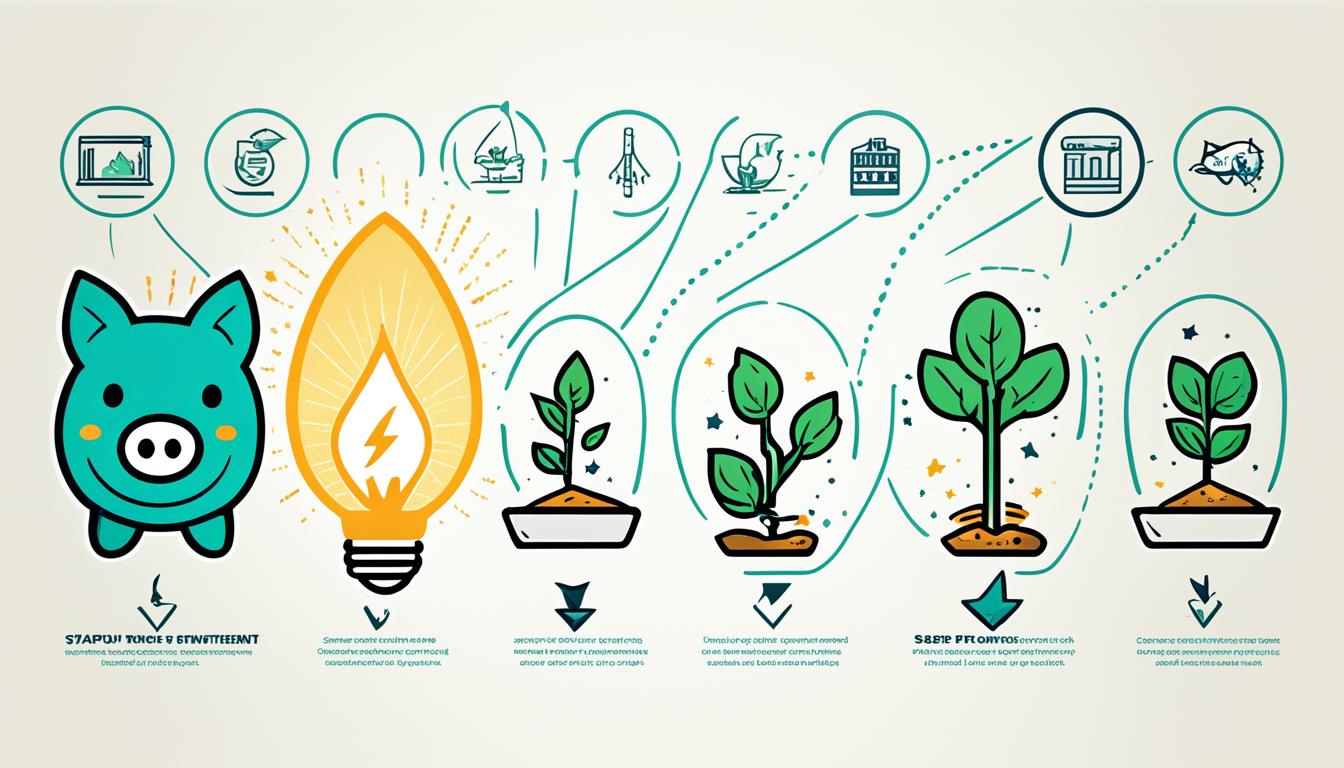Lead for Business’ Global Startup Database contains more than 500,000 records from 240 countries, with a 95% accuracy rate. This vast amount of startup funding data available online is a valuable resource for entrepreneurs and investors seeking promising opportunities. In today’s rapidly evolving market, utilizing this data is essential for comprehending market trends and making wise investment decisions.
Are you starting a new company, or are you an experienced investor? Either way, knowing how to use startup funding data is important. It helps shape your plans. Many platforms collect and look into this data. They give insights that help you understand the startup world better.
Key Takeaways
- The Global Startup Database provides extensive data with 500K+ records.
- Access to online funding data is essential for informed investment strategies.
- Many platforms offer specialized startup investment insights for various sectors.
- Understanding funding data can assist in market trend analysis.
- Multiple sources update their datasets frequently to ensure accuracy.
Understanding Startup Funding Data
Startup funding data is key information about the funds startups get from different stages of funding. As startups grow, knowing what startup funding data is becomes crucial for entrepreneurs and investors. This data shows how much money was raised, the funding type, and who the investors are. It’s the foundation for analyzing investments. Understanding this can significantly affect decisions on growing and expanding the business.
What is Startup Funding Data?
At the heart of it, startup funding data is about the numbers from funding rounds. This can be from early stages like pre-seed up to Series B and further. Pre-seed funding rounds often collect from $100,000 to $5 million. This early cash is vital for many startups. Angel investors and venture capital funds play a big role in providing this money. Their increasing involvement shows the popularity of dedicated pre-seed funding.
=3>a> In company>*=”0E.R3:4aAATVPJ-M-??/3+Ae-XI/R”>##SS>
Understanding how important funding data is can help a startup draw in more investors and sharpen its funding plans. During Series A funding, investors might get 10% to 30% equity. The average funds raised come to about $18.7 million by 2024. This data isn’t just numbers; it plays a big part in sizing up the competition. Seeing trends, like the median pre-money valuation at $6 million for seed funding in 2020, helps startups. They can see how they stack up against others and react to what the market wants.
Top 10 Startup Funding Data Sources
Startups need good funding data to guide their financial paths. The top sources offer insights that shape your business strategy. Here are the key platforms you should look at for funding information.
Overview of Key Platforms
Let’s dive into some of the top platforms for funding data and what they offer:
- Coresignal: Offers details on over 165,000 founders and 103 million company records. It’s great for understanding the market.
- Owler: Boasts an archive of 8.4 million records. It gives free insights to beat competitors.
- Wellfound: With 4.7 million records, it makes finding investors easier for startups.
- Pitchbook: A go-to for founder information. It’s vital for investors wanting deep insights.
- Crunchbase: Excels in funding round information. It’s a strong platform for comparing funding sources.
- CB Insights: Famous for technology trends and AI forecasts. Costs between $5k to $12k a month.
- VentureSource: Provides top-notch general company info. Essential for making informed choices.
- Fundz: At just $19 a month, it helps with sales prospecting and securing funding data.
- Tracxn: Sorts startups by industry and location, offering customized reports.
- Craft.co: Tracks startup performance indicators. It helps with understanding revenue and growth.

Comparative Analysis of Features
| Platform | Records | Strengths | Pricing |
|---|---|---|---|
| Coresignal | 165,000 Founders | Comprehensive data | Contact for pricing |
| Owler | 8.4 million | Free competitive insights | Free |
| Wellfound | 4.7 million | Investor connections | Contact for pricing |
| Pitchbook | Varied | Best for founder data | $1,500/month |
| Crunchbase | Varied | Robust funding rounds data | $348/user annually |
| CB Insights | Varied | Market trend analysis | $5,000-$12,000/month |
| Fundz | Varied | Sales prospecting | $19/month |
| Tracxn | Varied | Country and sector segmentation | Contact for pricing |
| Craft.co | Varied | Performance indicators | Contact for pricing |
Understanding the features of these platforms helps compare funding sources better. This way, you can find the best fit for your startup’s needs.
Where to Find Data on Startup Funding
Getting data on startup funding can really open your eyes to the fast-paced financial world. Many places exist where you can find this information, like exploring online databases or checking public records. These goldmines show what’s trending in fundraising and can help you make smart decisions.
Utilizing Online Databases and Reports
Databases like Datarade, Craft, and Intellizence are great for finding out about funding. They have tons of details on who got funded, how much, and in what industry. Take Kinisi and xAI, for example. They show the huge range of funding, from thousands to billions. And the industries? They cover everything from tech to health.
Exploring Public Records and Insights
But don’t stop at databases. Public records also tell a lot about funding rounds. You’ve got SEC filings, press releases, and reports full of info on who’s investing and how much. You’ll see patterns, like Series A funding being a big deal, throwing around millions. Spotting these trends can give you an edge in the investment game.

| Funding Type | Typical Amount Range | Example Companies |
|---|---|---|
| Pre-seed | $50,000 – $250,000 | New Ventures |
| Seed | $1,000,000 – $3,000,000 | Innovative Startups |
| Series A | $5,000,000 – $20,000,000 | Rapid Growth Companies |
| Post Series A | Exceeds $20,000,000 | Established Startups |
How to Navigate Funding Data Effectively
Searching through funding data needs a smart plan to sift through lots of information. Start by picking out key filters. This helps narrow down your search to what’s really important for your startup. Important filters include the stage of funding, the industry you’re in, and where you’re located.
Identifying Relevant Filters
Choosing the right filters is key to using funding information well. By setting certain criteria, you can make your search for funding more focused. Think about using these filters:
- Funding Stage: Seed, Series A, B, and so on.
- Industry: Areas like technology, healthcare, finance, and others.
- Geographical Location: Specific cities or states.
Making Use of User-Friendly Interfaces
Platforms that are easy to use make finding funding data simpler. They have designs that are easy to understand and tools that help you search better. When choosing a platform, think about these points:
| Platform | Ease of Use | Search Functionality | Data Depth |
|---|---|---|---|
| Crunchbase | High | Advanced filters available | Comprehensive |
| AngelList | Moderate | Basic filters | Focuses on startups |
| PitchBook | High | Very customizable | Very detailed |

Using these strategies makes it easier to navigate funding data. It also helps you make better decisions when looking for resources for your startup.
Utilizing Company Funding Data for Competitive Analysis
Using company funding data boosts your competitive analysis in today’s changing business world. It helps you see which sectors get more investments and spot fast-growing companies. This information is key for making smart choices and planning your strategy.
Understanding Market Trends and Insights
Looking into startup data shows important trends that affect your growth plans. With access to 17 million records from top sources, you understand the market better. Owler and Wellfound give you lots of data, with 8.4 million and 4.7 million records. This helps you see which areas are booming and where companies are getting funding.
Evaluating Competitors Through Funding Data
Checking how much money competitors get is crucial for understanding both direct and indirect rivals. Learning about their funding helps you get their strategy and future plans. A report shows 65% of investments are driven by data, underlining smart choices’ importance. Looking at funding patterns lets you see how companies stand out, using both numbers and unique qualities.
Here’s how your evaluation can unfold:
| Strategy Type | Examples | Impact |
|---|---|---|
| Quantitative Differentiation | Speed, Size, Price | Outperform competitors based on measurable factors. |
| Qualitative Differentiation | Branding, Marketing, Visual Appeal | Establish unique market positioning. |
| Market Disruption | Innovative Business Models | Enhance customer value and convenience. |
| Mapping Competitors | Perceptual or Value Proposition Mapping | Identify market gaps and growth opportunities. |
By using tools like Coresignal, businesses have seen up to a 25% jump in new projects in just two months, and 40% in six months. Knowing your position in the competitive field helps you adjust your strategy and focus on innovation.

Investment Intelligence: Analyzing Funding Rounds
Investment intelligence is key when looking at funding rounds. It helps spot companies with a big growth chance. Checking investment trends shows which fields are getting more funds, offering clues about where venture capital is heading.
Identifying High-Growth Potential Companies
To find high-growth companies, watch their funding rounds. The funds a company raises and its value show its potential. Early-stage startups may be worth between $3 million and $6 million. By Series A, they might hit a $24 million valuation.
But getting from seed to Series A is tough, with less than 10% making it. This shows the crucial step of picking right early on.
Tracking Investment Patterns
Looking at investment trends can teach us a lot. For example, in 2020, the average Series B fundraise was $33 million. By Series C, companies are on the path to an IPO, raising about $59 million. Spotting these shifts helps plan where to invest next.

Being able to follow these investment trends reveals when to invest or pull out. Tools like PitchBook, Crunchbase, and CB Insights offer detailed data on funding stages. This help investors make choices backed by market shifts.
| Funding Round | Average Amount Raised | Typical Valuation |
|---|---|---|
| Seed | $500,000 – $2 million | $3 million – $6 million |
| Series A | Varies widely | Around $24 million |
| Series B | $33 million | Around $40 million |
| Series C | $59 million | Around $68 million |
Global Perspectives: Funding Data Resources Outside the U.S.
Funding data from outside the U.S. offer valuable insights into global markets. They help shape your investment decisions and strategy. By exploring international funding, you can find great opportunities and spot new trends. This information is key as the startup funding scene changes worldwide.
International Databases and Their Relevance
Many global databases offer insights into startup funding worldwide. They provide a lot of info, helping you understand market trends and find sectors worth investing in. These databases are important because they show funding patterns you might miss in the U.S. alone.
- Crunchbase: A comprehensive platform that tracks global startup funding across sectors.
- PitchBook: Offers in-depth information on international venture capital and private equity funding.
- Dealroom: Focuses on European startups, featuring detailed reports on industry-specific funding trends.
- CB Insights: Provides analytics on global investment activities, showcasing interest in tech sectors worldwide.
Recent data show changes in global startup investment. In 2023, funding reached $285 billion, down 38% from $462 billion in 2022. Early-stage funding dropped over 40%, and late-stage funding fell by 37%. These numbers stress the importance of watching global trends to understand financial changes.

Emerging markets are reshaping the funding world. European startups, for example, are thriving. They overcome obstacles by offering innovative solutions and efficient operations. Grasping these trends can boost your planning and investing, letting you thrive in the global funding scene.
Valuing Startups Based on Funding Data
Knowing about different funding rounds is key to understanding a startup’s value. Each phase, from seed capital to Series A and B, affects how much a company is worth. Investors use this info to help decide where to put their money.
Understanding Funding Rounds and Their Impact
How much a startup is worth changes with each funding round. In 2019, seed deals were usually around $8 million. Series A rounds typically valued startups at about $20 million pre-money. Investors sometimes work backwards from how much company they want to own. They usually aim for 20% to 30% per round. A lot of competition can make the company’s value go up. This happens as founders gain the upper hand, often keeping more of the company for themselves.
Some companies, like Shyp, have struggled because they were valued too high and couldn’t meet expectations. Using SAFE or convertible notes can help. This way, companies like Part & Parcel in 2019 can delay setting a firm value while still getting money. It gives owners time to develop their business without rushing.
Valuing companies before they make money is a mix of art and science. Various methods exist, like the Berkus Method, which sets a $2 million cap for these companies. Or the Comparable Transactions Method, which looks at similar sales in the past. Valuations can vary a lot by industry, location, and the business stage.
| Valuation Method | Focus | Typical Valuation Range |
|---|---|---|
| Berkus Method | Stage of development | Pre-revenue: $0-2 million |
| Comparable Transactions Method | Market acquisitions | Varies widely |
| Scorecard Method | Team and market factors | Percentage-based valuations |
| Cost-to-Duplicate Approach | Replication costs | Depends on local market conditions |
| Discounted Cash Flow (DCF) | Established revenues | Not typical for early-stage |
As startups grow, valuation methods keep changing to stay accurate. Adapting to new circumstances lets investors and founders make smarter decisions.

Common Use Cases for Funding Data
Understanding funding data applications is key for businesses that want to grow. By using funding data, companies can make better decisions. This is true in various sectors.
Here are important ways funding data is used:
These uses help organizations find partners for mutual growth. With funding data, you can decide where to use your resources better. This leads to smarter planning.
Here’s a table showing common funding rounds and what they mean:
| Funding Round | Typical Amount Raised | Valuation Range | Key Insights |
|---|---|---|---|
| Seed Round | $10M – $15M | N/A | Essential for starting; often uses personal funds. |
| Series A | $7M – $10M | $30M – $60M | Shows the business works; important for growth. |
| Series B | $26M | $100M – $120M | Expands market and product development. |
| Crowdfunding | Varies | N/A | Helps show ideas to many; makes raising funds easier. |
| Loans | Varies (e.g., SBA loans) | N/A | Another way to get funds; usually doesn’t give away ownership. |

Conclusion
Finding startup funding data is key to understanding the business and investment world. This information is crucial for making wise decisions. It helps you navigate the startup environment with confidence.
There are many types of funding sources, from personal savings to venture capital. Knowing these can help you spot market trends and size up the competition. This knowledge shapes your growth strategies.
Being well-informed about startup funding can change your success rate. It’s vital for your startup’s future and the industry as a whole. For entrepreneurs and investors alike, using this data is important for growth and making smart choices.









